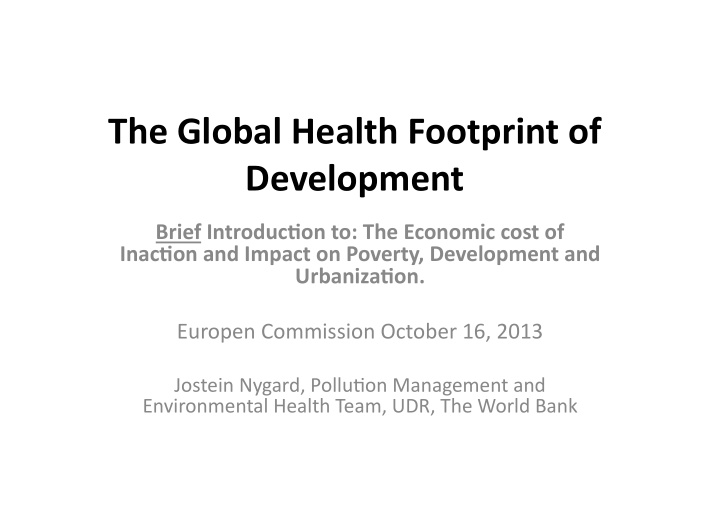



The ¡Global ¡Health ¡Footprint ¡of ¡ Development ¡ ¡ Brief ¡Introduc:on ¡to: ¡The ¡Economic ¡cost ¡of ¡ Inac:on ¡and ¡Impact ¡on ¡Poverty, ¡Development ¡and ¡ Urbaniza:on. ¡ Europen ¡Commission ¡October ¡16, ¡2013 ¡ Jostein ¡Nygard, ¡Pollu?on ¡Management ¡and ¡ Environmental ¡Health ¡Team, ¡UDR, ¡The ¡World ¡Bank ¡
Why ¡we ¡-‑ ¡the ¡World ¡Bank ¡-‑ ¡got ¡engaged ¡in ¡ the ¡GAHP ¡program: ¡ The ¡large ¡exposed ¡popula?on ¡at ¡the ¡global ¡level ¡in ¡LMICs. ¡Together ¡80 ¡million ¡in ¡ • defined ¡sectors: ¡ ¡lead ¡(20+), ¡mercury ¡(17+), ¡chromium ¡(15+), ¡heavy ¡metal ¡(25+), ¡e-‑ waste ¡(3+). ¡Total ¡about ¡200 ¡million. ¡ ¡ The ¡ ¡Toxic ¡Sites ¡Iden?fica?on ¡Program ¡(TSIP), ¡Na?onal ¡Plans ¡for ¡Toxic/Chemical ¡ • Management ¡and ¡concrete ¡pilot ¡plans ¡for ¡cleaning ¡up ¡contaminated ¡sites ¡appeared ¡ solid. ¡ ¡ Work ¡fit ¡in ¡with ¡our ¡new ¡focus ¡on ¡Pollu?on ¡Management ¡and ¡Environmental ¡ • Health ¡(PMEH). ¡ ¡ ¡ WB ¡funds ¡GAHP ¡ac?vi?es ¡with ¡a ¡Development ¡Grant ¡Facility ¡(DGF) ¡ • (2011/12-‑2014/15) ¡running ¡i ¡parallel ¡to ¡current ¡support ¡the ¡EC ¡and ¡others. ¡ ¡ Chair ¡the ¡GAHP ¡execu?ce ¡commi`ee ¡2012-‑15: ¡Try ¡to ¡bring ¡the ¡GAHP ¡partners ¡ • respec?ve ¡exper?se ¡and ¡resources ¡by ¡each ¡GAHP ¡partner ¡to ¡the ¡table ¡in ¡order ¡to ¡ meet ¡some ¡of ¡the ¡deman ¡by ¡client ¡countres. ¡ ¡ ¡
Implica?on ¡for ¡Economic ¡Growth. ¡ ¡ (ii) ¡Exposures ¡can ¡cause ¡long-‑term ¡developmental ¡and ¡ health ¡problems, ¡and ¡disability, ¡nega?vely ¡affec?ng ¡ produc?vity ¡and ¡ability ¡to ¡earn ¡income, ¡and ¡increasing ¡ health ¡care ¡costs ¡ (iii) ¡Toxic ¡chemicals ¡can ¡bio-‑accumulate ¡up ¡the ¡food ¡ chain, ¡impac?ng ¡agricultural ¡produc?on ¡and ¡can ¡ exacerbate ¡food ¡and ¡water ¡shortages ¡ (iii) ¡Urban ¡contamina?on ¡can ¡drive ¡down ¡property ¡value ¡ and ¡economic ¡investment ¡poten?als. ¡ However, ¡many ¡unknowns, ¡ore ¡studies ¡have ¡to ¡be ¡made ¡ (benefit ¡from ¡the ¡TSIP ¡etc). ¡
Fallout ¡of ¡IQ ¡decrements: ¡Damaging ¡consequences ¡for ¡ Economic ¡Growth. ¡ The ¡Weiss ¡Effect: ¡Impacts ¡of ¡Five ¡ Diminui?on ¡in ¡a ¡communi?es ¡ Point ¡IQ ¡reduc?on: ¡ intellectual ¡capacity ¡(reduc?on ¡in ¡# ¡ children ¡with ¡IQ ¡> ¡130) ¡ Reduce ¡the ¡socie?es ¡ability ¡to ¡be ¡ economically ¡produc?ve ¡and ¡a`ract ¡ investment. ¡ Increase ¡the ¡# ¡of ¡mentally ¡impaired ¡ children ¡(i.e. ¡# ¡of ¡children ¡with ¡IQ ¡< ¡ 70). ¡ Individuals ¡with ¡low ¡IQ ¡are ¡associate ¡ with ¡higher ¡crime ¡rates ¡and ¡societal ¡ violence. ¡ ¡ ¡
Sustainable ¡Development ¡ ¡ and ¡Poverty ¡Reduc?on ¡ (i) Poor ¡(low ¡income ¡groups) ¡dispropor?onately ¡ impacted, ¡especially ¡women, ¡fetuses ¡and ¡ children. ¡ (ii) 98% ¡of ¡adults ¡and ¡99% ¡of ¡children ¡affected ¡by ¡ exposure ¡to ¡lead ¡live ¡in ¡LMICs. ¡ ¡ (iii) In ¡LMICs, ¡poor ¡people ¡are ¡most ¡likely ¡to ¡be ¡ exposed ¡to ¡toxic ¡pollu?on ¡– ¡more ¡engaged ¡in ¡ hazardous ¡subsidence ¡level ¡livelihood ¡ac?vi?es. ¡ ¡ (iv) Poor ¡do ¡it ¡out ¡of ¡necessity ¡– ¡not ¡choice. ¡
Examples ¡of ¡poor ¡versus ¡rich ¡applying ¡protec?ve ¡ equipment ¡for ¡pes?cide ¡use ¡in ¡Vietnam. ¡ Quin:le ¡ Households ¡ Households ¡using ¡protec:ve ¡equipment ¡ ¡ using ¡pes:cide ¡ (when ¡using ¡pes:cide) ¡ Always ¡ Some?mes ¡ ¡ Never ¡ 1 ¡(poorest) ¡ 64% ¡ 57% ¡ 18% ¡ 25% ¡ 2 ¡ 73% ¡ 64% ¡ 17% ¡ 18% ¡ 3 ¡ 68% ¡ 67% ¡ 16% ¡ 17% ¡ 4 ¡ 52% ¡ 70% ¡ 14% ¡ 16% ¡ 5 ¡(richest) ¡ 35% ¡ 72% ¡ 11% ¡ 17% ¡ Total ¡ 61% ¡ 65% ¡ 16% ¡ 19% ¡
Far ¡the ¡most ¡polluted ¡loca?ons ¡combined ¡with ¡the ¡areas ¡of ¡ lowest ¡income ¡levels: ¡The ¡case ¡of ¡Ulaanbaatar, ¡Mongolia. ¡
Cost ¡effec?veness: ¡ ¡ The ¡case ¡of ¡Ulaanbaatar, ¡Mongolia. ¡
Value ¡of ¡Preven?ng ¡and ¡Cleaning ¡Up ¡ Sources ¡of ¡Toxic ¡Exposures ¡ Remedia:on ¡and ¡other ¡pollu:on ¡interven:ons ¡can : ¡ (i) ¡Expand ¡access ¡to ¡natural ¡resources ¡and ¡land ¡(i.e. ¡clean ¡water, ¡air, ¡ soil) ¡ (ii) ¡Free ¡up ¡land ¡for ¡other ¡purposes ¡(agriculture, ¡businesses/ ¡ development, ¡parks, ¡housing), ¡ ¡ (iii) ¡Help ¡relieve ¡pressure ¡from ¡rapid ¡urbaniza?on ¡ (iv) ¡Reduce ¡poverty ¡by ¡improving ¡environmental ¡health ¡and ¡mi?ga?ng ¡ exposure ¡risk ¡and ¡improving ¡income ¡through ¡more ¡effec?ve/efficient ¡ prac?ces ¡(i.e. ¡improved ¡recovery ¡of ¡lead ¡from ¡used ¡lead-‑acid ¡ba`eries ¡ or ¡gold ¡from ¡ar?sanal ¡mining) ¡ ¡
Next ¡steps ¡for ¡us ¡(the ¡World ¡Bank) ¡in ¡ suppor?ng ¡the ¡GAHP ¡program: ¡ Work ¡on ¡developing ¡a ¡Mul? ¡Donor ¡Trust ¡Fund ¡(MDTF) ¡on ¡Pollu?on ¡ • Management ¡and ¡Environmental ¡Health ¡(PMEH) ¡that ¡also ¡will ¡support ¡part ¡ of ¡the ¡GAHP. ¡ MDTF ¡to ¡run ¡in ¡parallel ¡to ¡other ¡support ¡to ¡the ¡GAHP ¡program. ¡MDTF ¡to ¡ • focus ¡on ¡con?nued ¡research, ¡na?onal ¡planning ¡(ensure ¡priori?za?on), ¡ capacity ¡building, ¡leading ¡to ¡specific ¡projects. ¡ Link ¡up ¡with ¡other ¡programs ¡the ¡WB ¡is ¡developing ¡on ¡Toxic ¡Chemicals ¡ • Management: ¡ ¡ ¡ ¡ ¡ ¡ ¡ ¡(i) ¡New ¡program ¡on ¡ «Se$ng ¡an ¡Ac+on ¡Agenda ¡for ¡Contaminated ¡Sites ¡– ¡ ¡ ¡ ¡ ¡ ¡ ¡ ¡ ¡ ¡ ¡ ¡ ¡Policy ¡and ¡Implementa+on»; ¡ ¡ ¡ ¡ ¡ ¡ ¡ (ii)Toxic ¡Chemical ¡Management ¡program ¡in ¡South ¡Saharan ¡ ¡Africa ¡(SSA); ¡ ¡ ¡ ¡ ¡ ¡ ¡(iii) ¡Lending/support ¡programs ¡in ¡selected ¡regions, ¡ ¡ ¡ ¡ ¡ ¡ ¡(iv) ¡Con?nued ¡support ¡to ¡the ¡GAHP. ¡
Recommend
More recommend